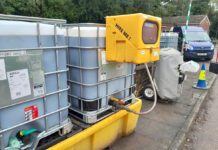Researchers from Spain have engineered a portable electronic nose that they suggest is almost as sharp as the human nose when it comes to sniffing out the problem odours of wastewater treatment plants. Mounted on a drone, the device can measure the concentration of different smells, predict odour intensity, and produce a real-time odour map of the plant, for management purposes.

Conventionally, a wastewater plant’s odour is often measured by dynamic olfactometry, where a human panel whiffs and analyzes bags of air collected from the plant. Although the method has been considered the gold standard, the process is costly, slow, and infrequent, which doesn’t allow operators to quickly respond to problems or pinpoint the root of the stench.
“I live two kilometers (1.2 miles) away from a wastewater treatment plant, and from time to time, you can’t even open the window because the smell is horrendous,” says senior author Santiago Marco of the Institute for Bioengineering of Catalonia. “We shouldn’t underestimate the impact to the quality of life for the people surrounding these facilities, and there are also physical and psychological consequences of being exposed to malodours.”
To better monitor wastewater plants’ odour emissions, Marco and his team designed a portable e-nose for real-time surveillance and data visualization with the help of AI. The team collected bags of air from a plant and trained the e-nose to sniff out pungent chemicals such as hydrogen sulphide, a, and sulphur dioxide, which smell like rotten eggs, urine, and burnt matches, respectively. The e-nose is also equipped with a sensor for carbon dioxide, an indicator of bacterial activity. In laboratory settings, the e-nose performed nearly as well as human noses.
The researchers then attached the 1.3-kg e-nose to a drone and sent it into the skies at a medium-size wastewater treatment plant in the south of Spain between January and June. Hovering over different facilities at the plant, the “sniffing drone” sucks in air via a ten-meter tube and analyzes the air in a sensor chamber.
“What’s tricky with odour measurement is that it’s a human perception, and it’s not well-defined,” says co-author Maria Deseada Esclapez of Depuración de Aguas del Mediterráneo, a sewage wastewater and sanitation service company. “We are not only trying to quantify particular or individual components of the emission, but also to predict the intensity of odours as perceived by humans.”
Pong panel
The results seemingly demonstrated that the e-nose on a drone was feasible for wastewater odour monitoring. When analyzing the same air samples in a field test, 10 out of 13 measurements from the e-nose aligned with the human panel’s assessments. Aided by the drone’s mobility and the AI algorithm, the team also mapped out the temporal and spatial odour concentration and, for the first time, predicted the intensity of the scent from drone measurements.
“We are extremely happy with the results, but we need more validation and to make the device more robust for a real plant operation,” said Marco. The team plans to shave off some extra weight from the e-nose and develop a standardized process for the method. They are also planning to further optimize the device in the way it compensates for influence from temperature, humidity, and other conditions that can affect accuracy.






